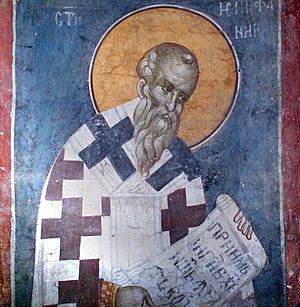Epiphanius of Salamis facts for kids
Quick facts for kids SaintEpiphanius of Salamis |
|
|---|---|

St. Epiphanius in a fresco painting (Gračanica Monastery)
|
|
| Bishop of Salamis (Cyprus), Oracle of Palestine | |
| Born | c. 310–320 Judea |
| Died | 403 (aged 82–93) at sea |
| Venerated in | Catholicism Eastern Orthodoxy Oriental Orthodoxy |
| Feast | 12 May 17 Pashons (Coptic Orthodoxy) |
| Attributes | Vested as a bishop in omophorion, sometimes holding a scroll |
| Controversy | Iconoclasm |
Epiphanius of Salamis (born around 310–320 AD, died in 403 AD) was an important Christian leader. He served as the bishop of Salamis, Cyprus, in the late 300s. Both the Eastern Orthodox and Catholic Churches consider him a saint and a Church Father. This means he was an influential early Christian writer and teacher.
Epiphanius was known for strongly defending what he believed was the correct Christian faith. His most famous work is the Panarion. This book describes and argues against eighty different heresies, which were beliefs that went against the main Christian teachings of his time. He also wrote about pagan religions and philosophical ideas. Epiphanius was one of the first church leaders to speak out about how Christian images were used. He was clearly against some ways images were used in churches back then.
Life of Epiphanius
Epiphanius was born near a place called Eleutheropolis in Judea. He was either born into a Christian family with Jewish roots or became a Christian when he was young. He lived as a monk in Egypt, where he studied and learned a lot. While there, he met groups with different Christian beliefs.
Around 333 AD, Epiphanius returned to Roman Palestine. He was still young and started a monastery nearby. A monastery is a place where monks live and worship together. He became a priest and led this monastery for thirty years. During this time, he became very skilled and knowledgeable. He could speak many languages, including Hebrew, Syriac, Egyptian, Greek, and Latin. Because of this, he was called Pentaglossos, meaning "Five-tongued."
His great knowledge led to him becoming the Bishop of Salamis, Cyprus, in 365 or 367 AD. He held this important position until he died. He was also the main bishop for the Church of Cyprus. He served as a bishop for almost forty years. During this time, he traveled widely to challenge beliefs he thought were wrong. For example, he attended a meeting in Antioch in 376 AD. There, he discussed important questions about the Trinity against a belief called Apollinarianism. He also attended a big meeting in Rome in 382 AD, continuing to defend his views.
Epiphanius's Writings
Epiphanius wrote several important books.
The Panarion
His most famous book is the Panarion, also known as Adversus Haereses, which means "Against Heresies." The name Panarion comes from a word meaning "bread basket." Epiphanius saw his book as a basket full of "antidotes" or cures for people who were "bitten" by wrong beliefs. He wrote it between 374 and 377 AD. It was like a guide for dealing with arguments from people with different ideas.

The Panarion lists and argues against 80 different heresies. Some of these beliefs are only known to us because Epiphanius wrote about them. He started by talking about four "mothers" of pre-Christian heresies: 'barbarism,' 'Scythism,' 'Hellenism,' and 'Judaism.' Then he discussed 16 pre-Christian heresies, including four types of philosophical schools and 12 Jewish groups. After that, he wrote about 60 Christian heresies, from different Gnostic groups to various beliefs about the Trinity in the 300s.
Epiphanius was very passionate about his beliefs. Sometimes, he even admitted that he wrote against some groups based only on what he heard. However, the Panarion is still a very valuable source of information. It tells us a lot about the Christian Church in the 300s. It also gives us important details about early Jewish gospels, like the Gospel of the Hebrews, which were used by groups like the Ebionites and Nazarenes.
A unique part of the Panarion is how Epiphanius compares different heretics to poisonous animals. He would describe the animal's features, how it makes poison, and how to protect yourself from its bite. For example, he called his opponent Origen "a toad noisy from too much moisture." He compared the Gnostics to a dangerous snake "with no fangs." He described the Ebionites, a Christian group that followed Jewish law, as "a monstrosity with many shapes." In total, Epiphanius described fifty different animals, usually one for each group he wrote about.
The Panarion also helps us learn about books that are now lost. It includes parts of works by other early Christian writers like Justin Martyr, Irenaeus, and Hippolytus. The Panarion was first translated into English in the late 1980s and early 1990s.
Other Important Works
Epiphanius's earliest known book is the Ancoratus, which means "the well-anchored man." This book argued against beliefs like Arianism and the teachings of Origen.
He also wrote a book about the Bible called On Weights and Measures. He wrote this in 392 AD for a Persian priest. It talks about the books of the Old Testament, different measurements and weights used in the Bible, and the geography of Palestine. Even though it seems like rough notes, Epiphanius's work on measurements was very important in the history of measurement.
Another work, On the Twelve Gems (De Gemmis), talks about different precious stones. A letter he wrote to John, Bishop of Jerusalem, in 394 AD, is also still known today.
Epiphanius was so famous for his learning that a book called the Physiologus was often wrongly said to be written by him. This book was a main source for medieval bestiaries, which were collections of stories about real and mythical animals.
See also
 In Spanish: Epifanio de Salamina para niños
In Spanish: Epifanio de Salamina para niños

